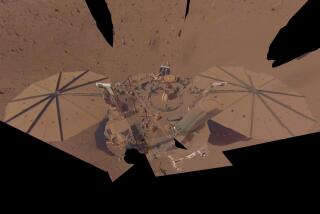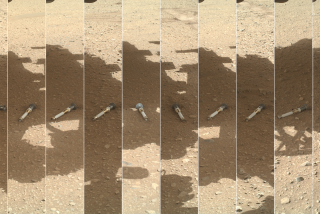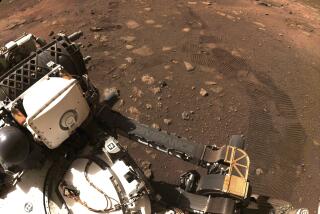Rover Finds Evidence That Mars Had Water
The Mars rover Opportunity has discovered that potentially life-sustaining waters once soaked the surface of Mars, providing an answer to one of the most provocative questions of modern planetary science.
At a news conference Tuesday in Washington, NASA scientists said analysis of rock samples showed that salt-laden sediments were shaped by percolating or flowing water -- and may even have been formed by a great Martian sea.
“Opportunity has landed on an area of Mars where liquid water once drenched the surface,” said Ed Weiler, NASA’s associate administrator of space science. “This area would have been a good, habitable environment for some period of time.”
He called the findings “a giant leap” toward determining whether life may have existed on Mars during a warmer and wetter time in the now-frigid planet’s past.
Steve Squyres, a Cornell University geologist and chief scientist for the mission, said one of the key pieces of evidence was the discovery of dense deposits of sulfates -- similar to earthly Epsom salts -- in an outcropping of bedrock near Opportunity’s landing site.
The mineral is typically left behind by receding groundwater or the evaporation of a salty lake or ocean.
Scientists used a grinding tool to look beneath the surface of the rock to be sure the salty deposits were more than a shallow crust. They then used an instrument called an alpha particle X-ray spectrometer, which can be used to shoot radioactive particles at mineral atoms to determine their mass and composition.
The rocks were found to be “full of sulfate salts,” up to 40% of the total mass of the rocks, Squyres said -- “a telltale sign, we believe, of water.”
Squyres said several other findings confirmed their assumptions.
The layered, scarred face of a rock scientists have been studying -- nicknamed El Capitan -- could have been shaped by wind or water. But a striated pattern called crossbedding included concave patterns typically caused by the crest lines of underwater ridges.
The rover’s panoramic camera and microscopic imager captured a number of random, pockmark indentations, each a fraction of an inch long. The pattern typically forms when salt crystals grow within rocks sitting in briny water. When the crystals later dissolve or erode away, they leave holes like those seen on El Capitan.
Pebble-like structures the scientists nicknamed “blueberries,” embedded in the rock like berries in a muffin, could have been formed by volcanic eruptions or by the violent force of a meteor impact. But scientists concluded that they were more likely “concretions,” structures created from mineral deposits emerging from a watery solution inside the rock formation.
This combination of signs convinced the rover team that water must have been the unifying basis for the rock’s characteristics.
“You work so hard on something,” said Matt Golombek, a geologist at the Jet Propulsion Laboratory in Pasadena who led the site-selection process and hit the jackpot. “You dream about it, but it was almost too much to hope for.”
Scientists are still exploring whether Mars had large standing bodies of surface water or if the water bubbled up from underground. They don’t know if the water was present thousands of years ago or much further back in the planet’s history.
But the scientists are certain that large volumes of water shaped the rocks at the Opportunity site over a long period.
Although it is too soon to tell if there was ever life on Mars, the question of whether the planet was capable of sustaining some form of life has been laid to rest, the scientists said.
“This is a significant step in answering the fundamental question ‘Are we alone in the universe?’ ” said Roger Launius, former chief historian at NASA.
It also represented a crucial triumph for the agency, still reeling from last year’s Columbia space shuttle disaster. NASA recently refocused its work toward what it hopes will be an eventual human voyage to Mars.
“People may look back 10 or 20 years from now and see the [rovers] as the beginning of the resurrection of NASA,” said Howard McCurdy, a space science historian at American University in Washington.
Charles Elachi, director of JPL, which built and operates the two rovers now on Mars, said that if the discovery is a first step to finding life on other planets, it could begin an epic shift in human self-perception, comparable to when 16th century astronomers determined that the Earth was not the center of the universe.
The mystery of Martian water dates from the observations of American astronomer Percival Lowell a century ago, who described Martian “canals” amid vegetation and cities. His fanciful conclusions touched off a furious debate about the role of water on Earth’s planetary neighbor.
For more than four decades, space probes from the former Soviet Union, the United States and other nations tried to settle the question -- resulting in a cost of tens of billions of dollars and failure in 20 of 36 missions.
But periodic successes slowly chipped away at the daunting target. Polar icecaps were discovered in 1965 in a fly-by made by the U.S. space probe Mariner 4. In 1971, Mariner 9, the first successful Mars orbiter, showed canyons and what looked like dry river beds.
The Odyssey orbiter now circling Mars used infrared cameras to peer underground -- finding vast ice fields beneath the surface. The cameras also mapped the presence of hematite, a mineral often formed by water flows.
Opportunity landed on Mars on Jan. 24. Its twin, Spirit, landed at Gusev Crater on the other side of the Red Planet on Jan. 3.
Like most good science, the current rover missions have raised more questions than they have answered. The rovers cannot date Martian rocks or detect mineral signatures left by living organisms. Nor can they test the possibility that liquid water may still exist far beneath the surface.
“What happened to the water? What happened to atmosphere? Why does a planet like Mars not seem to hold on to them?” McCurdy asked.
Within a decade, NASA hopes to complete a mission in which a rover collects rocks and soil and brings back the samples to begin to answer some of those questions, Weiler said.
Today’s success is “very gratifying,” mission scientist Squyres said. “On the other hand, we are just getting started.”






